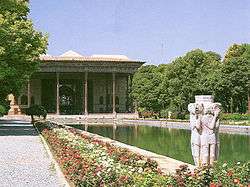Isfahani style
The "Esfahani" or "Isfahani style" (شیوه معماری اصفهانی) is a style (sabk) of architecture when categorizing Iranian architecture development in history. Landmarks of this style span through the Safavid, Afsharid, Zand, and Qajar dynasties starting from the 16th century to the early 20th century.[1]
The Isfahani style is the last style of traditional Persian—Iranian architecture.[2]
The Safavid dynasty were chiefly instrumental in the emergence of this style of architecture, which soon spread to India in what became known as Mughal architecture.
Examples
Examples of the Isfahani style include:
See also
Gallery
-

Hasht Behesht palace
-

Imam Mosque, Isfahan
References
- ↑ Fallāḥʹfar, Saʻīd (سعید فلاحفر). The Dictionary of Iranian Traditional Architectural Terms (Farhang-i vāzhahʹhā-yi miʻmārī-i sunnatī-i Īrān فرهنگ واژههای معماری سنتی ایران). Kamyab Publications (انتشارات کامیاب). Kāvushʹpardāz. 2000, 2010. Tehran. ISBN 978-964-2665-60-0 US Library of Congress LCCN Permalink: http://lccn.loc.gov/2010342544 pp.26
- ↑ Sabk Shenasi Mi'mari Irani (Study of styles in Iranian architecture), M. Karim Pirnia. 2005. ISBN 964-96113-2-0 pp.272
External links
This article is issued from Wikipedia - version of the 5/25/2014. The text is available under the Creative Commons Attribution/Share Alike but additional terms may apply for the media files.

